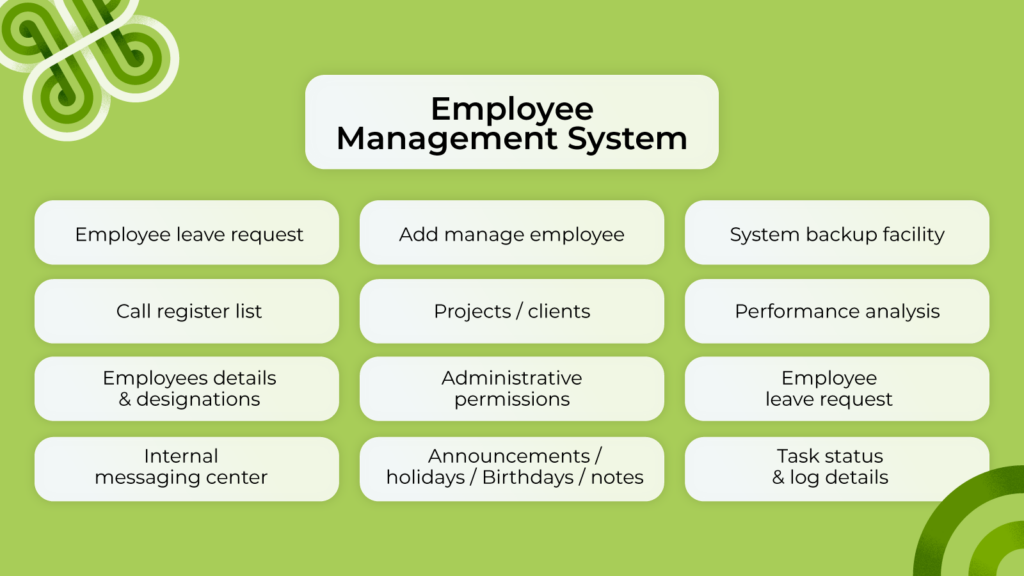How employee management software is changing the game

Businesses are constantly seeking ways to optimize their operations and achieve managerial excellence. This quest for efficiency has given rise to the adoption of Employee Management Software (EMS). No longer just a cutting-edge luxury, EMS has established itself as an indispensable tool for contemporary business operations.
At its core, EMS is a comprehensive software platform designed to manage various aspects of employee-related functions. From tracking work hours, managing schedules, and overseeing task assignments to facilitating communication, performance evaluations, and employee benefits and administration, EMS provides a unified solution to a multitude of HR challenges.
The transformative impact of EMS on the workplace is multifaceted. Firstly, it significantly reduces administrative burdens, automating tasks that previously demanded extensive manual input. This automation leads to a notable increase in accuracy and efficiency.
Furthermore, with real-time data and analytics at their fingertips, managers can make informed decisions swiftly, enhancing both responsiveness and strategic planning. For employees, EMS offers clarity in roles, responsibilities, and performance metrics, the employee management app fostering a sense of transparency and empowerment.
In summary, as businesses navigate the complexities of the digital age, Employee Management Software emerges as a beacon of efficiency and streamlined employee management systems. It’s not just about automating tasks; it’s about reshaping the very fabric of the modern workplace, making it more cohesive, transparent, and agile.

Key features of employee management software
Time and attendance tracking
Gone are the days of the antiquated punch-in cards, a relic of a bygone era. In today’s digital age, Employee Management Software (EMS) platforms have revolutionized the way businesses monitor their workforce.
With sophisticated digital tools at their disposal, these platforms provide seamless solutions for tracking employee hours, managing leave requests, and overseeing overtime allocations. The benefits of such digital tracking are manifold.
For one, it greatly enhances payroll accuracy. By automating timekeeping and leave management, discrepancies and manual errors become a thing of the past, ensuring employees receive their due compensation without glitches.
Additionally, with precise digital employee records now, businesses can effortlessly ensure compliance with labor laws, avoiding potential legal pitfalls and fostering a transparent work environment.
In essence, the transition from manual punch-in cards to advanced EMS platforms signifies more than just technological advancement; it represents a shift towards efficiency, accuracy, and a commitment to ensuring fairness and transparency in the workplace.
Performance management
Gauging the heartbeat of your team, understanding their strengths, challenges, and aspirations, is crucial in today’s dynamic business environment.
Employee Management Software (EMS) serves as a compass in this endeavor, offering a suite of tools that provide real-time insights into the workforce’s performance and alignment with organizational objectives.
Through EMS, businesses can efficiently track Key Performance Indicators (KPIs), those critical metrics that provide a snapshot of individual and team productivity and effectiveness. But it doesn’t stop there. With functionalities for goal-setting, EMS allows managers and employees to collaboratively establish clear, measurable targets, ensuring a shared vision and direction.

Furthermore, the performance review tools embedded within EMS streamline the feedback process. Managers can provide timely, constructive feedback, celebrating achievements and addressing areas of improvement.
This continuous loop of goal-setting, monitoring, and feedback ensures that every member of the team is not only aware of the company’s vision but is also actively working towards it.
In essence, an EMS acts as the bridge between organizational strategy and individual contribution, ensuring that the team’s pulse beats in harmony with the company’s overarching goals and aspirations.
Task delegation and monitoring
Efficiency is paramount, and cumbersome email threads can often lead to confusion and missed opportunities. Modern Employee Management Software (EMS) platforms offer a solution to this challenge by centralizing task management within a singular, intuitive dashboard.
Within this consolidated space, managers can effortlessly delegate tasks to team members, clearly define objectives, and set precise deadlines.
This structured approach not only streamlines the allocation process but also ensures clarity of roles and responsibilities, reducing the potential for misunderstandings.
Furthermore, the real-time monitoring capabilities of these dashboards provide an at-a-glance view of the progress of various assignments.
Managers can instantly identify which tasks are on track, which ones might require additional resources, and which are nearing completion. This level of oversight ensures timely interventions, adjustments, and feedback, promoting a proactive management style.
In summary, the shift from endless email chains to a unified EMS dashboard signifies a move towards greater organizational clarity, agility, and productivity, ensuring that teams can focus on what truly matters: delivering exceptional results.
Benefits of using employee management software
Improved efficiency and productivity
The power of automation in today’s business landscape cannot be overstated. By streamlining and automating mundane and repetitive tasks, businesses are liberated to channel their energies and resources towards more strategic and value-driven endeavors.
Employee Management Software (EMS) is a testament to this shift, offering a plethora of tools designed to enhance efficiency and accessibility.
Within these advanced platforms, employees can effortlessly access their work schedules, eliminating the ambiguity and confusion that can sometimes arise from manual scheduling methods.
The ease of communication is another standout feature, enabling team members to interact with their peers, share updates, and collaborate on projects with just a few simple clicks. This integrated communication fosters a sense of community and cohesion within the organization.
Moreover, the feedback mechanism within EMS platforms is streamlined for maximum impact. Managers can promptly provide constructive feedback, and employees can receive and act upon it almost instantaneously, ensuring continuous growth, employee satisfaction and alignment with organizational standards.
In essence, the move towards automation via EMS is not merely about technological advancement; it’s about reshaping the workplace experience. By simplifying processes and enhancing accessibility, businesses can ensure that their focus remains unwaveringly on driving innovation, growth, and excellence.

Reduced errors
One of the most noteworthy advantages of digitization is its ability to drastically reduce the likelihood of manual errors.
When tasks are carried out manually, there’s a higher susceptibility to human oversights, inaccuracies, or miscalculations. For instance, consider payroll processing. Traditionally, calculating salaries, deductions, bonuses, and other financial components were done by hand or through basic spreadsheets.
This method not only consumed a significant amount of time but also posed risks of discrepancies due to manual entry. Similarly, attendance tracking, which involves keeping track of employees’ in-times, out-times, leaves, and breaks, was another area prone to errors when done manually.
With the advent of digitization, automated software and systems have been developed to handle these tasks. These digital platforms use algorithms and data analytics to ensure precision and consistency, thereby minimizing potential errors.
As a result, businesses and organizations can now enjoy greater accuracy, efficiency, and peace of mind, knowing that their data is being managed with the utmost care and precision through digital means.
Enhanced communication and collaboration
Silos, be gone! With the introduction of Employee Management Software (EMS) platforms, businesses now have the means to champion real-time communication and collaboration.
These sophisticated systems are adept at seamlessly bridging gaps between various departments, ensuring that information flows smoothly and teams can work in harmony.
By eliminating these barriers, EMS platforms play a pivotal role in cultivating a unified and cohesive work environment where collaboration is not just encouraged but becomes an integral part of the organizational culture.
In essence, these platforms transform traditionally segmented workplaces into interconnected hubs, driving efficiency and fostering a sense of unity across the board.
Data-driven decision making
Having a clear understanding of metrics and performance indicators is indispensable. With the integration of analytics and reporting tools, managers are now equipped with a wealth of information at their fingertips.
These tools provide detailed insights into various facets of operations, from employee performance to project timelines. By analyzing this data, managers can make well-informed decisions that are grounded in tangible evidence, ensuring that strategies are both effective and relevant.
Beyond decision-making, these analytical tools also empower managers to discern emerging trends, allowing them to anticipate challenges and seize opportunities.
This proactive approach, facilitated by comprehensive reporting, enables businesses to optimize their operations, streamline processes, and enhance overall efficiency.
In essence, the convergence of analytics and management paves the way for a more agile, responsive, and informed business environment.

How to choose the right employee management software
In the diverse world of business, no two enterprises are identical, each having its distinct challenges, aspirations, and operational nuances.
This uniqueness extends to the selection of an Employee Management Software (EMS). While there’s a plethora of EMS options available in the market, it’s imperative for businesses to choose one that resonates with their specific needs and ethos.
Factors like scalability become paramount, ensuring the software can grow and adapt as the business evolves. Integration capabilities are equally crucial, allowing for seamless harmony with existing systems and tools.
The user interface, often overlooked, plays a pivotal role in determining user adoption and overall efficiency; a user-friendly interface can significantly enhance the user experience and boost productivity.
Additionally, robust customer support ensures that any issues or queries are addressed promptly, minimizing disruptions. Ultimately, the chosen EMS should not only meet operational requirements but also echo the company’s values, culture, and long-term vision. By making a thoughtful selection, businesses can ensure they have a tool that not only streamlines processes but also fortifies their strategic trajectory.
Potential challenges and solutions
Embracing Employee Management Software (EMS) undoubtedly brings a plethora of advantages to the modern workplace, from streamlined operations to enhanced communication. However, the journey of integrating such systems is not always smooth sailing.
One of the foremost concerns that often emerges is data privacy. Given the sensitive nature of employee information, ensuring its security and confidentiality is paramount. Additionally, the human element cannot be overlooked; employees might exhibit resistance to change, especially if they are accustomed to traditional methods.
This resistance can stem from apprehension about the new system or fear of redundancy. And, like any other software, EMS platforms are not immune to technical hitches or glitches that can disrupt operations.

Yet, these challenges are not insurmountable. With comprehensive training sessions, businesses can equip their workforce with the skills and confidence to navigate the new system effectively.
Transparent communication plays a vital role in addressing concerns and dispelling myths, ensuring that the entire organization is on the same page regarding the EMS’s benefits and functionalities.
Lastly, partnering with a reputable and reliable vendor can substantially reduce the risk of technical issues while also providing assurance in terms of data security. In essence, while the road to EMS integration might have its bumps, with a proactive and thoughtful approach, businesses can ensure a transition that is both smooth and beneficial.
Conclusion
The dawn of a new era in employee management is upon us, characterized by digital transformation and technological prowess.
As the corporate world rapidly evolves, adapting to its changing contours becomes essential, and integrating a robust Employee Management Software (EMS) stands at the forefront of this adaptation.
The paradigm is shifting; where once businesses were mired in manual processes that consumed valuable time and resources, the emphasis now is on harnessing digital tools to elevate strategic initiatives and add genuine value to operations.
By leveraging EMS, organizations can streamline functions, enhance communication, and drive efficiencies, all while ensuring their workforce remains engaged and empowered. This transition from traditional methods to a digital-centric approach is not just a trend but a fundamental change in how businesses operate and thrive.
So, as the digital wave sweeps the corporate landscape, the pertinent question arises: Are you poised to embrace this change and propel your organization into the future of employee management?
Discover how DevSkiller employee management system can help you.
Schedule a demo with one of our product experts or watch this quick 5-min demo video to find out more.
FAQs
- What is Employee Management Software?
It’s a digital solution that aids businesses in managing, tracking, and optimizing various employee-related tasks and activities. - How does EMS improve efficiency?
By automating routine tasks, providing real-time data, and enhancing communication. - Can small businesses benefit from EMS?
Absolutely! There are scalable solutions available for businesses of all sizes. - Is data security a concern with EMS?
While most reputable vendors prioritize security, it’s always essential to review a software’s security protocols before integration. - How often should EMS be updated?
Regular updates are crucial to address bugs, enhance features, and ensure compatibility with other systems.
Share post